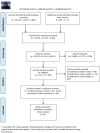The effectiveness of smoking cessation, physical activity/diet and alcohol reduction interventions delivered by mobile phones for the prevention of non-communicable diseases: A systematic review of randomised controlled trials
- PMID: 29304148
- PMCID: PMC5755775
- DOI: 10.1371/journal.pone.0189801
The effectiveness of smoking cessation, physical activity/diet and alcohol reduction interventions delivered by mobile phones for the prevention of non-communicable diseases: A systematic review of randomised controlled trials
Abstract
Background: We conducted a systematic review to assess the effectiveness of smoking cessation, physical activity (PA), diet, and alcohol reduction interventions delivered by mobile technology to prevent non-communicable diseases (NCDs).
Methods: We searched for randomised controlled trials (RCTs) of mobile-based NCD prevention interventions using MEDLINE, EMBASE, Global Health, CINAHL (Jan 1990-Jan 2016). Two authors extracted data.
Findings: 71 trials were included: smoking cessation (n = 18); PA (n = 15), diet (n = 3), PA and diet (n = 25); PA, diet, and smoking cessation (n = 2); and harmful alcohol consumption (n = 8). 4 trials had low risk of bias. The effect of SMS-based smoking cessation support on biochemically verified continuous abstinence was pooled relative risk [RR] 2.19 [95% CI 1.80-2.68], I2 = 0%) and on verified 7 day point prevalence of smoking cessation was pooled RR 1.51 [95% CI 1.06-2.15], I2 = 0%, with no reported adverse events. There was no difference in peak oxygen intake at 3 months in a trial of an SMS-based PA intervention. The effect of SMS-based diet and PA interventions on: incidence of diabetes was pooled RR 0.67 [95% CI 0.49, 0.90], I2 = 0.0%; end-point weight was pooled MD -0.99Kg [95% CI -3.63, 1.64] I2 = 29.4%; % change in weight was pooled MD -3.1 [95%CI -4.86- -1.3] I2 0.3%; and on triglyceride levels was pooled MD -0.19 mmol/L [95% CI -0.29, -0.08], I2 = 0.0%. The results of other pooled analyses of the effect of SMS-based diet and PA interventions were heterogenous (I2 59-90%). The effects of alcohol reduction interventions were inconclusive.
Conclusions: Smoking cessation support delivered by SMS increases quitting rates. Trials of PA interventions reporting outcomes ≥3 months showed no benefits. There were at best modest benefits of diet and PA interventions. The effects of the most promising SMS-based smoking, diet and PA interventions on morbidity and mortality in high-risk groups should be established in adequately powered RCTs.
Conflict of interest statement
Figures






















References
-
- World Health Organization. Global status report on noncommunicable diseases 2014. 2014.
-
- Lim SS, Vos T, Flaxman AD, Danaei G, Shibuya K, Adair-Rohani H, et al. A comparative risk assessment of burden of disease and injury attributable to 67 risk factors and risk factor clusters in 21 regions, 1990–2010: a systematic analysis for the Global Burden of Disease Study 2010. The Lancet. 2012;380(9859):2224–60. 10.1016/S0140-6736(12)61766-8 - DOI - PMC - PubMed
-
- Beaglehole R, Bonita R, Horton R, Adams C, Alleyne G, Asaria P, et al. Priority actions for the non-communicable disease crisis. The Lancet. 2011;377(9775):1438–47. - PubMed
-
- Bonita R, Magnusson R, Bovet P, Zhao D, Malta DC, Geneau R, et al. Country actions to meet UN commitments on non-communicable diseases: a stepwise approach. The Lancet. 2013;381(9866):575–84. - PubMed
Publication types
MeSH terms
LinkOut - more resources
Full Text Sources
Other Literature Sources

